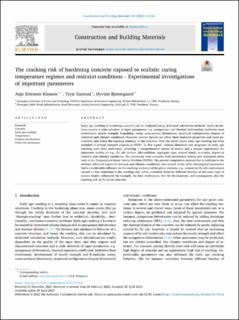| dc.description.abstract | Early age cracking in hardening concrete can be evaluated using dedicated calculation methods. Such calculations require a wide selection of input parameters, e.g. autogenous- and thermal deformation, hydration heat evolvement, tensile strength, E-modulus, creep, cross-section dimensions, structural configuration (degree of restraint) and climatic conditions. However, several factors can affect these materials properties and input parameters, and hence the cracking tendency of the concrete. Over the recent years, early age cracking has been included in several research projects at NTNU. In this regard, various laboratory test programs on early age cracking have been performed, providing a comprehensive matrix of results and a unique opportunity for parameter studies on e.g., fly ash content, SRA-addition, aggregate type, cement batch, w/c-ratio, degree of restraint and climatic conditions. The laboratory tests comprise both mechanical testing and restrained stress tests in the Temperature-Stress Testing Machine (TSTM). The present compilation showed that in addition to the obvious effects of degree of restraint and climatic conditions, also several of the other investigated parameters had a considerable influence on the cracking tendency of the given concrete, e.g., cement-by-fly ash replacement caused a clear reduction of the cracking risk, while variations between different batches of the same type of cement highly influenced the strength, the heat evolvement, the AD development, and consequently also the cracking risk of the given concrete. | en_US |

